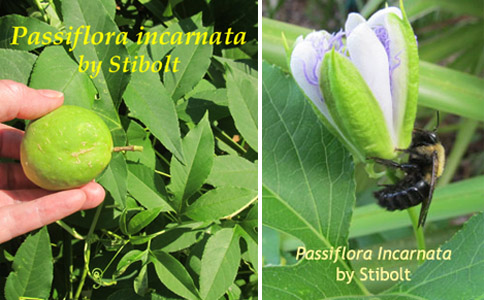 |
| Passionvine has a wonderfully complex flower. |
Passionvine, purple passion flower, maypop (Passiflora incarnata) is a beautiful perennial native vine with a wonderfully complex flower with crimped petal-like tepals. It dies back to the ground in the winter, but pops up in more places the next spring–in May usually.
It’s widely distributed from Florida to Texas and northward to Pennsylvania. It can be propagated by cuttings, seed, or by digging up its sprouts when they’ve come up in an inconvenient place.
The plants were given the name passionflower or passionvine by early Spanish explorers because the floral parts were once said to represent aspects of the Christian crucifixion story or the Passion. The ten petal-like parts represent the disciples, excluding Peter and Judas; the five stamens the wounds Jesus received; the knob-like stigmas the nails; the fringe the crown of thorns. The more mundane name “maypop” comes from its sprouting from dormancy in May and that the hollow, ripened fruits that pop loudly when crushed.
Passionvines invite butterflies, bees, and other pollinators to your garden.
 |
| Like most gardeners, I love beautiful plants that attract many pollinators. And for a vine like this, adorning the trelliswork is the ideal location. It’s beautiful, isn’t it? |
 |
| I look forward to making juice from its fruit. It is the passion fruit that gives Hawaiian Punch its zip. And I love watching the carpenter bees waiting for the flower to open in the morning. |
This plant is also the larval host plant for gulf fritillary (Agraulis vanillae), variegated fritillary (Euptoieta claudia), Julia (Dryas iulia) and zebra longwing (Heliconius charitonius) butterflies.
It’s said that if the passionvine grows in the shade, it will attract the zebra longwing, our state butterfly. I haven’t seen many of the zebra longwing larvae, so I can’t really verify that, but I have witnessed a lot of the gulf fritillary activity in the sun or the shade.
 |
| The female gulf fritillary butterfly first “tastes” the leaf with her feet and then she lays her eggs… |
 |
| Gulf fritillary eggs are spread around the leaves. |
Did I say hungry??
 |
| Wow! These hungry fritillary caterpillars ate the whole vine and the fruits, too. |
Now that vine on the trellis may not so beautiful to others, but for me, I love a moth-eaten or butterfly-eaten landscape.
My name is Ginny and I am a butterfly gardener! Won’t you join me as a full-fledged member of Butterfly Gardeners Anonymous (BGA) and proudly proclaim your butterfly-eaten landscape to be beautiful?
© Ginny Stibolt

